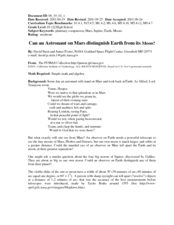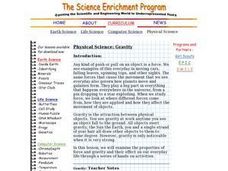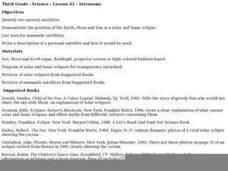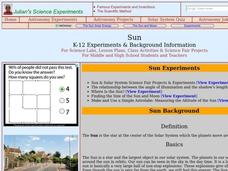Aquarium of the Pacific
Turn a Cow into a Whale
Third graders explore animals that might have a common ancestor and resemble one another. For this cow and whale lesson, 3rd graders recognize the similarities between the whale and the cow. Students complete worksheets based...
Curated OER
Can an Astronaut on Mars Distinguish Earth from its Moon?
Learners explore the possibility of being on Mars and being able to identify the Earth. In this space lesson students complete a set of calculations to see if this is possible.
Curated OER
Tracking Satellites Using Latitude and Longitude
Students, viewing an Internet site, plot the path of several satellites using latitude and longitude over the course of an hour. They learn the four basic types of satellites and their purpose.
Curated OER
Wobbling in Circles
Sixth graders role play the parts of the sun, the moon and the Earth as they simulate the concepts of revolution and rotation. They act out the parts in small groups and discuss the concepts as a class.
Curated OER
Physical Science: Gravity
Students investigate the properties of force and gravity and their effects on everyday life. In groups, they test various balls by bouncing them on different surfaces and observe the properties. In another activity, they test marbles and...
Curated OER
We're Going on an Animal Safari!
Students take viewers on an animal safari. In this technology instructional activity, students research animals one would see on an African safari. Students collaborate to create a storyboard and use Flip Video Cameras to create a...
Curated OER
The Climate Change Skeptic's Argument: Natural Solar Cycles or Human Activity?
Teachers explore patterns in sunspots and total solar irradiance to understand the counterpoint to the human effect of global warming. In this professional development tool, teachers work through a lesson on the sun's natural...
Curated OER
Climate Mime-it
Students pantomime new climate vocabulary words. In this climate lesson plan, students go over new vocabulary words and their meanings. Students form groups and pantomime these word's definitions.
Curated OER
The Mathematical Dynamics of Celestial Navigation and Astronavigation
High schoolers explore the different methods used in celestial Navigation and astronavigation. In this math lesson, students construct a sextant and demonstrate how it works.
Curated OER
Finding the Way
Students identify and research navigational tools used in deep sea explorations. They are introduced to a compass, the Global Positioning System and sonar technology and then describe their uses in underwater exploration.
Curated OER
Book Report Haiku
Students study another method for writing a book report using a Haiku poem. In this book report instructional activity, students use the Haiku poem format to write a book report.
Curated OER
Science - Lesson 42 - Astronomy
Third graders demonstrate the position of the Earth, Moon, and Sun in a solar and lunar eclipse. They list uses for manmade satellites and write a description of how a satellite would be use.
Curated OER
The Chinese Zodiac
Students create their own personalized Zodiac page on a word processing
document after researching and discussing the origins of Zodiak signs. This lesson does include resource links and may be controversial.
Curated OER
The Chinese Zodiac And The Western Zodiac
Students create individual horoscopes that contrast and compare Western and
Chinese views of their futures using poster boards and magic markers. In-class discussion is used to evaluate the use of the Zodiac in different cultures.
Curated OER
Pinhole Viewer
Students make a pinhole viewer to demonstrate how it inverts light passing through it which produces inverted images.
Curated OER
Follow The Falling Meteorite
Learners investigate the supposed traveling path of a meteorite. They use sound in order to triangulate the path. The results of the experiment are written on a map to display the path of the meteorite. The culminating activity is when...
Curated OER
Asteroids
Students examine the different types of asteroids and how they enter the atmosphere. In this space lesson students use mashed potatoes to create an asteroid they can eat.
Curated OER
Sun
Students study how the sun is at the center of the solar system. In this solar lesson students measure the altitude of the sun and its size.
Curated OER
Science vs. Science Fiction
Young scholars acknowledge the difference between science and science fiction through a compare/contrast activity. They discuss their reading materials together. Students identify characteristics specific to science fiction.
Curated OER
Meteors
Students identify the different types of meteorite using an interactive website. In this earth science lesson plan, students simulate how meteors crash on a surface. They relate meteor size to crater size.
Curated OER
My Alien
Young scholars listen to text read from "Hello! Anybody Out There?" and then brainstorm what aliens from outer space look like and do they exist at all.
They then will describe the physical features and a special ability or quality of...
Curated OER
Seeing Interference Fringes with a Telescope
Students construct an interferometer using a simple telescope. In this physics lesson, students explain how light waves create the fringe patterns. They observe patterns made by different objects in the sky and compare them.
Curated OER
Hubble Space Telescope Webquest
Students research the Hubble Space Telescope. In this Hubble Space Telescope lesson, students complete a webquest about the Hubble Space Telescope.
Curated OER
SALLY RIDE
Pupils express what it would be like to launch off into outer space in a space shuttle. They include what it might feel like, look like, sound like, and any thoughts that go through their mind as they dart away from the Earth's atmosphere.
Other popular searches
- Stars and Planets Worksheets
- Stars and Planets Puzzles
- Planets and Stars
- Comparing Planets and Stars























